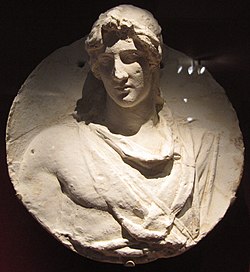| Treasure of Begram | |
|---|---|
 Helmeted Athena, Treasure of Begram, Guimet Museum (MG19073) | |
| Period/culture | 1st or 2nd century CE |
| Discovered | 34°58′00″N69°18′00″E / 34.966667°N 69.300000°E |
| Place | Bagram (Begram), Afghanistan. |
The Treasure of Begram or Begram Hoard is a group of artifacts from the 1st-2nd century CE discovered in the area of Begram, Afghanistan. The French Archaeological Delegation in Afghanistan (DAFA) conducted excavations at the site between 1936 and 1940, uncovering two walled-up strongrooms, Room 10 and Room 13. Inside, a large number of bronze, alabaster, glass (remains of 180 pieces), coins, and ivory objects, along with remains of furniture and Chinese lacquer bowls, were unearthed. Some of the furniture was arranged along walls, other pieces stacked or facing each other. [1] [2] In particular, a high percentage of the few survivals of Greco-Roman enamelled glass come from this discovery.
Contents
- History
- Major artifacts
- Glass
- Ivory
- Plaster
- Other materials
- See also
- References
- Further reading
- External links
The Begram ivories are a sub-group of over a thousand decorative plaques, small figures and inlays, carved from ivory and bone, and formerly attached to wooden furniture. They are rare and important exemplars of Kushan art of the 1st or 2nd centuries CE, attesting to the cosmopolitan tastes and patronage of local dynasts, the sophistication of contemporary craftsmanship, and to the ancient trade in luxury goods. [3] [4]














